Refrigeration is used to assure proper storage temperature of food products. This is most often accomplished by using the vapor compression cycle. In this technique, refrigerant vapor is compressed by a compressor, condensed into a liquid in a con-denser by the rejection of heat, expanded by a restrictive device, and fed into an evaporator where heat is absorbed and returned to the compressor to complete the cycle. See Figure 1.
Most commonly, the evaporator cools air, which is then used to cool the product. Due to inefficiencies of the heat transfer pro-cess, the temperature of the refrigerant in the evaporator is 5˚F to 16˚F (3 to 9K) colder than the air temperature.
Obviously, even products that must be stored above freezing temperatures will require evaporator surface temperatures below the freezing point of water. For example, fresh meat is often stored at 34 to 36˚F (1 to 2˚C), so the evaporator surface will be between 24 and 31˚F (-5 and -1˚C). Since ice will form at 32˚F, the evaporator surface will begin to build a covering of ice. The coating is referred to as “frost”, and is seen in a number of different forms. The layer of frost closest to the surface of the evaporator will tend to be a hard form of ice similar to ice cubes.
Figure 1 Basic Vapor Compression Cycle
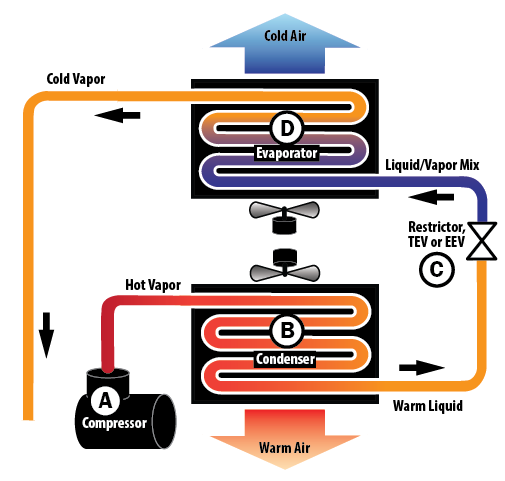
Depending on humidity, evaporator temperature and air flow, subsequent layers of frost may be more crystalline or snow-like. This is referred to as hoar frost. In some instances frost will not begin to form until the coil surface reaches temperatures near 26˚F (-5˚C), but the need for some defrost is almost universal.
Many low temperature evaporator coils have widely spaced fins to provide space for frost to build before seriously imped-ing air flow. Typical fin spacing for low temperature evapora-tors is 4 per inch, but no more than 6 per inch. Medium or high temperature evaporators will have 6 to 8 or more fins per inch, while air conditioning coils may have 12 or more fins per inch. Because heat transfer capacity is directly related to the surface area of the evaporator, fewer fins per inch will require a physi-cally larger evaporator for a given capacity. Conversely, if frost on the evaporator can be limited to small amounts, it is possible that a smaller and more economical evaporator could be used.
Although pure ice has a thermal conductivity four times that of water (this means it conducts heat four times as well as water), as air becomes entrained in the flaky hoar frost, the frost be-comes an insulator and will reduce the ability to absorb heat. This insulating effect, along with the restriction of air flow across the frosted evaporator, means that at some point the coil must be, “de-frosted”.
ASHRAE studies (1998 R42.3) have shown that the heat transfer ability of the evaporator actually increases when a thin layer of frost develops. This is likely due to the increase in surface area of the tube, and a slight increase in the velocity of the air due to the reduction in area of the air passages through the evaporator. See Figure 2.
Empirical testing has shown that the optimum time to defrost is when the evaporator loses about 10% efficiency. Traditional methods of defrost, based on time, cannot ascertain this loss of efficiency and will either waste time and energy in excessive de-frosting, or never fully defrost the evaporator.
Figure 2 Air Flow Thru Frosted Coil
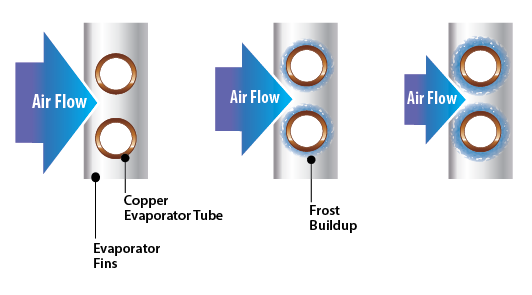
Newer “smart” methods of defrost attempt to overcome the time-based versions with mixed success. However, KE2 Therm Solutions has provided the industry with a state of the art algo-rithm incorporated into its products. The KE2 Therm Evap as-certains the state of the evaporator and initiates a defrost when it has lost only 10% of maximum. Field trials have shown 25% energy savings and a reduction in the number of defrosts. In one instance, the KE2 Therm Evaporator Efficiency reduced the number of defrosts to once every 2.5 days from once every 8 hours, in the previous time based system.
In addition to the energy savings from fewer defrosts, the KE2 Therm Evaporator Efficiency provides steadier temperature control of the room and product. One of the unique features of the controller is fan cycling and compressor cycling during “cool” mode. Frost or ice on the evaporator surface can be used to help cool the room by remelting. Each pound of frost or ice melted will contribute an additional 1,200+ BTUs of refrigera-tion. Not only is the evaporator kept at optimum heat transfer ability, but free cooling and re-humidification of the product is provided by the KE2Therm solution.
Common methods of defrosting include; off cycle, electric and hot gas.
Off Cycle Defrost
Off cycle defrost simply involves turning off the refrigeration system while letting the fans run continuously. Since the air must be warmer than 32˚F (0˚C), off cycle defrost is only use-ful on coolers for storage of beverages and produce. The chief advantage of off cycle defrost is the simplicity and economy of installation. However, the fans must run during both cooling and defrost mode. This can use more energy than needed for proper cooling.
Since the KE2 Therm Evaporator Efficiency cycles fans during cooling, it can achieve additional energy savings in fan power.
Electric Defrost
The second most common method of defrosting is by electric heat. The evaporators must be designed and built for this type of defrost and incorporate passages through the evaporator fins, generally parallel to the refrigeration tubing. Long electric resistance heaters are placed into provided passages and are energized to raise the temperature of the evaporator surface above freezing.
Although simple to install and control, electric defrost can be very expensive in terms of energy use. The heaters are ener-gized for the duration of the defrost cycle and can use about 1 kW per foot of evaporator length.
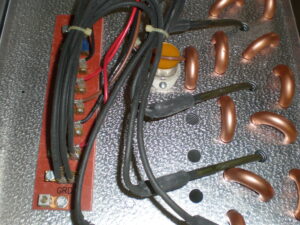 Since standard timed defrosts are usually set for 3 per day and may last 30 to 60 minutes, the power consumption can be sig-nificant. In addition, the surface temperature of the heater it-self can exceed 300˚F, and any melted frost that comes into contact with the element will flash into steam and re-condense on cold surfaces in the refrigerated room. Often this will ap-pear as layers of ice on the ceiling of the room, and it will not be removed during a routine defrost. Occasionally, an electric defrost will be extended to try to remove this buildup, keeping the heaters energized beyond the time needed for defrosting the evaporator. This can actually scorch the evaporator or other room components.
Since standard timed defrosts are usually set for 3 per day and may last 30 to 60 minutes, the power consumption can be sig-nificant. In addition, the surface temperature of the heater it-self can exceed 300˚F, and any melted frost that comes into contact with the element will flash into steam and re-condense on cold surfaces in the refrigerated room. Often this will ap-pear as layers of ice on the ceiling of the room, and it will not be removed during a routine defrost. Occasionally, an electric defrost will be extended to try to remove this buildup, keeping the heaters energized beyond the time needed for defrosting the evaporator. This can actually scorch the evaporator or other room components.
Electric defrost must be closely controlled to make sure it is as effective and as efficient as possible.The KE2Therm Evap control pulses the defrost heaters to assure the proper amount of heat needed for defrosting, without overheating or wasting energy. The algorithm limits the surface temperature of the heaters to prevent steaming, while also lowering the energy used to guar-antee a complete defrost.
Hot Gas Defrost
The third common type of defrost is hot gas, some versions are known as cool gas. This is the most complex and expensive to install, but the quality and effectiveness of the defrost is better than the other defrost methods. In hot gas defrost, the liquid refrigerant flowing through the evaporator is interrupted, and instead, a supply of gas directly from the discharge of the com-pressor is used. This “gas” is really superheated compressed refrigerant vapor and can easily exceed 200˚F. Since this hot vapor is actually inside the tubes of the evaporator, it applies heat to the frost where it forms on the tube. The hot gas travels throughout the entire tubing circuit, and will therefore defrost areas of the evaporator that may not be as effectively reached by electric resistance heaters. In many cases, the flow of the hot gas is in the reverse direction from that of the cooling mode. This is called reverse cycle hot gas defrost and is the primary method used in supermarkets. Figure 3a and 3b illustrate this method.
The cool gas version is essentially the same, except that the gas used for defrosting is obtained from the receiver, rather than di-rectly from the compressor discharge.
Figure 3a Cooling Mode
Figure 3b Reverse Cycle Hot Gas Defrost
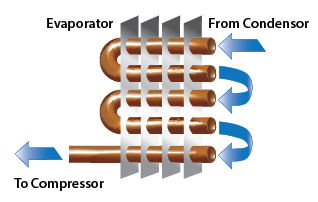
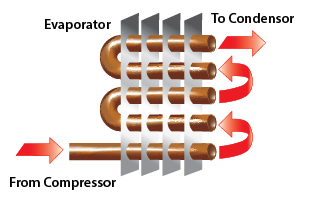
In either of these two types of defrosts, the fans should not only be off during the defrost cycle, but must be held off for some time after the defrost terminates. During a defrost, water is formed on the evaporator as the ice melts. Once the defrost ter-minates, the water must be allowed to drain from the coil. This “drip time” prevents moisture from being blown off the coil and refreezing on the cold product, or other surfaces in the room. Some evaporators are equipped with a thermostat to delay starting the fans until the coil has dried or gotten cold enough to re-freeze the remaining moisture.
Algorithms and sensors included in the KE2Therm Evaporator Efficiency controller package automatically perform this func-tion without any additional thermostats or fan delay relays.
Evaporator temperatures below the freezing point of water are often needed to keep foods and other products safe to use and convenient to store. Ice or frost buildup on these evaporators is inevitable but methods to remove it are well proven and easy to implement. Newer technology allows even smarter methods to be applied now and in the future.
The KE2Therm Evaporator Efficiency is advantageous with this type of defrost. By reducing the number and frequency of defrosts, cooling and room temperature are more consistent, excessive heating is reduced, and pull-down of the evaporator temperature after a defrost is faster.
As stated earlier, consistent limitation of the amount of frost on the evaporator has a direct saving in installation. Limiting the amount of frost formed, and assuring complete defrosting, permits the use of a coil with more fins per inch. This, in turn, may allow a physically smaller and less expensive evaporator to be used — saving product cost, installation cost, weight and refrigerant charge. The KE2Therm Evap controller is proven to; control the amount of frost on the evaporator. Less expensive evaporators can be considered using the KE2Therm Evaporator Efficiency controller.
The KE2Therm Evaporator Efficiency is the product to use to increase the efficiency of the evaporator, provide closer temperature control of the product and save energy, truly the “ Key To” state of the art refrigeration control.
